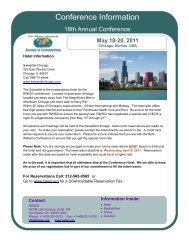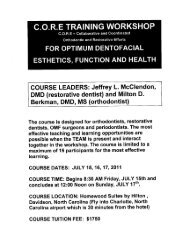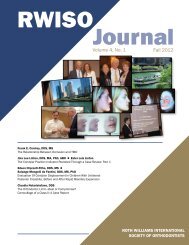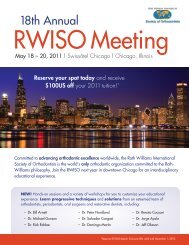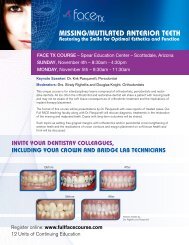2010 RWISO Journal - Roth Williams International Society of ...
2010 RWISO Journal - Roth Williams International Society of ...
2010 RWISO Journal - Roth Williams International Society of ...
Create successful ePaper yourself
Turn your PDF publications into a flip-book with our unique Google optimized e-Paper software.
tion might have enabled us to circumvent pathologic tooth<br />
wear while the patient was undergoing treatment?<br />
In canine guidance, the horizontal forces are minimized<br />
by limiting the contact <strong>of</strong> the supporting cusps with their opposing<br />
fossae at or near their intercuspal position. All other<br />
lateral contacts are prevented by the steeper inclination <strong>of</strong><br />
the canines. This causes the chewing movement to be more<br />
vertical in the frontal view. Case 5 exemplifies the preservation<br />
<strong>of</strong> tooth material in the presence <strong>of</strong> functional occlusion.<br />
Upon lateral excursive movements, the canine guidance<br />
provided sufficient clearance in the posterior teeth.<br />
Many <strong>of</strong> our orthodontic patients already have worn<br />
canines and incisors. Occlusal interferences, premature contacts,<br />
and habitual bruxism and/or clenching all may act as<br />
stressors. Tooth contact during swallowing occurs 2,400<br />
times a day, according to Straub23 and Kydd. 24 These repetitive<br />
static and cyclic occlusal loads could also cause wear<br />
on the anterior, as well as the posterior, teeth. Although it is<br />
difficult to quantify the amount <strong>of</strong> tooth wear precisely, especially<br />
in cross-sectional studies, orthodontists can appraise<br />
attrition <strong>of</strong> the incisal edges and canine tip most easily from<br />
intraoral photographs. Why should orthodontists be aware<br />
<strong>of</strong> tooth wear? What happens if the dentist ignores if they<br />
ignore the problem? These are important questions, because<br />
any patient who is not informed <strong>of</strong> tooth surface loss is put<br />
at risk <strong>of</strong> having no choice in treating what can become a<br />
severe condition. ■<br />
References<br />
1. Jablonski, S. Jablonski’s Dictionary <strong>of</strong> Dentistry. 2nd ed. Philadelphia:<br />
Saunders, 1992.<br />
2. Litonjua L, Andreana S, Bush PJ, et al. Tooth wear: attrition, erosion,<br />
and abrasion. Quintessence Int. 2003;(34):435-446.<br />
3. Grippo J, Simring M, Schreiner S. A new perspective on tooth surface<br />
lesions. J Am Dent Assoc. 2004;135(8):1109-1118.<br />
4. Badel T, Keros J, Šegović S, Komar D. Clinical and tribological view<br />
on tooth wear. Acta Stomatol Croat. 2007;41(4):355-365.<br />
5. Hand J, Beck J, Turner K. The prevalence <strong>of</strong> occlusal attrition and<br />
considerations for treatment in a noninstitutionalized older population.<br />
Spec Care Dentist. 1987;(7):202-206.<br />
6. Sivasithamparam K, Harbrow D, Vinczer E, et al. Endodontic sequelae<br />
<strong>of</strong> dental erosion. Aust Dent J. 2003;(48):97-101.<br />
7. Schneider P, Peterson J. Oral habits: considerations in management.<br />
Pediatr Clin North Am. 1982;(29):523-546.<br />
8. Dugmore C, Rock W. The prevalence <strong>of</strong> tooth erosion in 12-year-old<br />
children. Br Dent J. 2004;196(5):279-282.<br />
68 Linton, Jung | The Effect <strong>of</strong> Tooth Wear on Postorthodontic Pain Patients: Part 2<br />
9. Bardsley P, Taylor S, Milosevic A. Epidemiological studies <strong>of</strong> tooth wear<br />
and dental erosion in 14-year-old children in north west England, part I:<br />
the relationship with water fluoridation and social deprivation. Br Dent J.<br />
2004;197(7):413-416.<br />
10. Cordray F. Centric relation treatment and articulator mountings<br />
inorthodontics. Angle Orthod. 1996;66(2):153-158.<br />
11. Lee R. Jaw movements engraved in solid plastic for articulator controls,<br />
part I: recording apparatus. J Prosthet Dent. 1969;(22):209-224.<br />
12. Academy <strong>of</strong> Prosthodontics. Glossary <strong>of</strong> prosthodontic terms.<br />
J Prosthet Dent. 2005;94(7):10-92.<br />
13. Lundeen H. Centric relation records: the effect <strong>of</strong> muscle action.<br />
J Prosthet Dent. 1974;31(3):244-253.<br />
14. Crawford S. Condylar axis position, as determined by the occlusion<br />
and measured by the CPI instrument, and signs and symptoms <strong>of</strong> temporomandibular<br />
dysfunction. Angle Orthod.1999;69(2):103-116.<br />
15. Hunt K. Bioesthetics: Working with nature to improve function and<br />
appearance. Am Acad Cosmet Dent. 1996;12(2):45-50.<br />
16. Hunt, K. Full-mouth rejuvenation using the biologic approach: an 11year<br />
case report follow-up. Contemp Esthet Restor Pract. 2002;6(6):1-6.<br />
17. Lee R. Esthetics and its relationship to function. In: Rufenacht CR, ed.<br />
Fundamentals <strong>of</strong> Esthetics. Chicago: Quintessence; 1990:137-209.<br />
18. Hunt K, Turk M. Correlation <strong>of</strong> the AACD accreditation criteria and<br />
the human biologic mode. J Cosmet Dent. 2005;21(3):120-131.<br />
19. Ash M, Nelson S. Dental Anatomy, Physiology and Occlusion. 8th ed.<br />
St Louis, MO: Saunders; 2003.<br />
20. Knight D, Leroux B, Zhu C, Almond J, Ramsay D. A longitudinal<br />
study <strong>of</strong> tooth wear in orthodontically treated patients. Am J Orthod<br />
Dent<strong>of</strong>ac Orthop. 1997;112(6):17-18.<br />
21. Masatoshi K, Masanori F. Occlusal factors associated with temporomandibular<br />
disorder based on a prospective cohort study <strong>of</strong> young adults.<br />
Prosthod Res Pract. 2006;5(2):72-79.<br />
22. Jemt T, Lundquist S, Hedegard B. Group function or canine protection.<br />
J Prosthet Dent. 1982;(48):719-724.<br />
23. Straub W. Malfunctions <strong>of</strong> the tongue. Am J Orthod. 1960;(40):404-420.<br />
24. Kydd W. Maximum forces exerted on the dentition by the perioral and<br />
lingual musculature. J Am Dent Assoc. 1957;(55):646-651.



